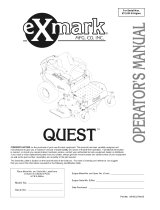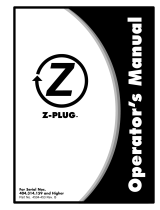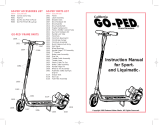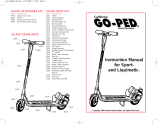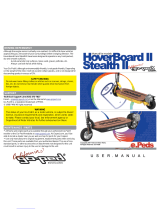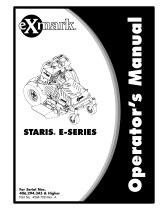Page is loading ...

Count on it.
0
CL
0
Form No. 3369-575 Rev A
TimeCutter_ SS 4235, SS4260, SS
5000 and SS 5060 Riding Mowers
Model No. 74624mSerial No. 311000001 and Up
Model No. 74625mSerial No. 311000001 and Up
Model No. 74626_Serial No. 311000001 and Up
Model No. 74630_Serial No. 311000001 and Up
Model No. 74632_Serial No. 311000001 and Up
To register your product or download an Operator's Manual or Parts Catalog at no charge, go to www.Toro.com. Original Instructions (EN)

This machine is a ride-on, rotary-blade lawnmower
intended to be used by homeowners in residential
applications. It is primarily designed for cutting grass
on well-maintained lawns. It is not designed for cutting
brush, mowing grass and other growth alongside
highways, or for agricultural uses.
CALIFORNIA
Proposition 65 Warning
The engine exhaust from this product
contains chemicals known to the State of
California to cause cancer, birth defects,
or other reproductive harm.
Important: This engine is not equipped with a
spark arrester muffler. It is a violation of California
Public Resource Code Section 4442 to use or operate
the engine on any forest-covered, brush-covered, or
grass-covered land. Other states or federal areas
may have similar laws.
This spark ignition system complies with Canadian
ICES-002.
Removing standard original equipment parts and
accessories may alter the warranty, traction, and
safety of the machine. Failure to use original Toro
parts could cause serious injury or death. Making
unauthorized changes to the engine, fuel or venting
system, may violate EPA and CARB regulations.
Replace all parts including, but not limited to, tires,
belts, blades, and fuel system components with
original Toro parts.
The enclosed Engine Owner's Manual is supplied
for information regarding the US Environmental
Protection Agency (EPA) and the California
Emission Control Regulation of emission systems,
maintenance, and warranty. Replacements may be
ordered through the engine manufacturer.
For models with stated engine horsepower, the gross
horsepower of the engine was laboratory rated by the
engine manufacturer in accordance with SAE J1940.
As configured to meet saferB emission, and operating
requirements, the actual engine horsepower on this class
of lawn mower will be significantly lower.
Introduction
Read this information carefully to learn how to operate
and maintain your product properly and to avoid injury
and product damage. You are responsible for operating
the product properly and safely.
You may contact Toro directly at www.Toro.com for
product and accessory information, help finding a
dealer, or to register your product.
Whenever you need service, genuine Toro parts, or
additional information, contact an Authorized Service
Dealer or Toro Customer Service and have the model
and serial numbers of your product read> Figure i
identifies the location of the model and serial numbers
on the product. Write the numbers in the space
provided.
\\
Figure 1
Under the seat
1. Model and serial number plate
G014523
Write the product model and serial numbers in the space
below:
Model No.
Serial No.
This manual identifies potential hazards and has
safety messages identified by the safety alert symbol
(Figure 2), which signals a hazard that may cause serious
injury or death if you do not follow the recommended
precautions.
Figure 2
1. Safety alert symbol.
© 2011--The Toro® Company
8111 Lyndale Avenue South
Bloomington, MN 55420
Contact us at www.Toro.com.
Printed in the USA.
All Rights Reserved

This manual uses two other words to highlight
information. Important calls attention to special
mechanical information and Note emphasizes general
information worthy of special attention.
Contents
Introduction ................................................................. 2
Safety ........................................................................... 4
Safe Operating Practices ....................................... 4
Toro Riding Mower Safety .................................... 6
Slope Indicator ..................................................... 7
Safety and Instructional Decals ............................. 8
Product Overview ...................................................... 14
Controls ............................................................. 15
Operation ................................................................... 16
Think Safety First ............................................... 16
Before Starting ................................................... 18
Starting the Engine ............................................. 19
Operating the Blades .......................................... 20
Testing the Safety Interlock System ..................... 20
Stopping the Engine ........................................... 2i
DrNing ............................................................... 2i
Stopping the Machine ......................................... 22
Adjusting the Height of Cut ................................ 22
Positioning the Seat ............................................ 23
Adjusting the Motion Control Levers .................. 23
Pushing the Machine by Hand ............................. 24
Grass Deflector .................................................. 24
Operating Tips ................................................... 25
Maintenance ............................................................... 27
Recommended Maintenance Schedule(s) ................ 27
Premaintenance Procedures .................................... 28
Raising the Seat .................................................. 28
Lubrication ............................................................. 28
Greasing the Bearings ......................................... 28
Engine Maintenance ............................................... 29
Servicing the Air Cleaner .................................... 29
Servicing the Engine Oil ..................................... 30
Servicing the Spark Plug ..................................... 32
Cleaning the Cooling System ............................... 33
Fuel System Maintenance ....................................... 33
Replacing the In-line Fuel Filter .......................... 33
Servicing the Emissions Filter ............................. 34
Electrical System Maintenance ................................ 34
Charging the Battery ........................................... 34
Servicing the Fuses ............................................. 35
Drive System Maintenance ..................................... 36
Checldng the Tire Pressure ................................. 36
Releasing the Electric Brake ................................ 36
Mower Maintenance ............................................... 37
Servicing the Cutting Blades ............................... 37
Leveling the Mower Deck ................................... 40
Removing the Mower ......................................... 42
Mower Belt Maintenance .................................... 43
Installing the Mower ........................................... 44
Replacing the Grass Deflector ............................. 44
Cleaning ................................................................. 45
Washing the Underside of the Mower .................. 45
Storage ....................................................................... 46
Cleaning and Storage .......................................... 46
Troubleshooting ......................................................... 48
Schematics ................................................................. 50

Safety
This machine meets or exceeds the B71.1-2003
specifications of the American National Standards
Institute, in effect at the time of production.
However, improper use or maintenance by the
operator or owner can result in injury. To reduce
the potential for injury, comply with these safety
instructions and always pay attention to the
safety alert symbol, which means CAUTION,
WARNING, or DANGER-"personal safety
instruction." Failure to comply with the instruction
may result in personal injury or death.
Safe Operating Practices
This product is capable of amputating hands and
feet and throwing objects. Always follow all safety
instructions to avoid serious injury or death.
The following instructions are from ANSI standard
B7I.I-2003. All the language within this ANSI standard
applies to this machine; however, due to the application
of the standard across ma W different types of products
some statements can seem general or misleading. In
these instances, _[bro has refined the statement to convey
the meaning of the standard while better matching
the product this Operator's Mazual pertains. Safety
information in addition to the instructions found in
the ANSI standard below can be found in _fbro Riding
Mower Safety at the end of this section.
General Operation
• Read, understand, and follow all instructions in
the operator's manual and on the machine before
starting.
• Do not place hands or feet near rotating parts or
under the machine. Keep clear of the discharge
opening at all times.
• iMlow only responsible adults who are familiar with
the instructions to operate the machine.
• Clear the area of objects such as rocks, toys, wire,
etc., which could be picked up and thrown by the
blade.
• Be sure the area is clear of other people before
mowing. Stop the machine if anyone enters the area.
• Never carry passengers.
• Do not mow in reverse unless absolutely necessar>
Always look down and behind before and while
backing up.
• Be aware of the mower discharge direction and do
not point it at awone. Avoid discharging material
against a wall or obstruction. Material may ricochet
back toward the operator. Stop the blade(s) when
crossing gravel surfaces.
Do not operate the machine without deflector,
discharge cover or entire grass collection system in
place and working.
Be alert, slow down and use caution when malting
turns. Look behind and to the side before changing
directions.
• Never leave a running machine unattended. Always
turn off blades, set parldng brake, stop engine, and
remove key before dismounting.
• Turn off blades when not mowing. Stop the engine,
wait for all parts to come to a complete stop
and remove the key before cleaning the machine,
removing the grass catcher or unclogging the
discharge chute.
• Operate the machine only in daylight or good
artificial light.
• Do not operate the machine while under the
influence of alcohol or drugs.
• Watch for traffic when operating near or crossing
roadways.
• Use extra care when loading or unloading the
machine into a trailer or truck.
Always wear eye protection when operating the
mower.
• Data indicates that operators, age 60 years and
above, are involved in a large percentage of riding
mower-related injuries. Operators should evaluate
their ability to operate the tiding mower safely
enough to protect themselves and others from
serious injur>
• Always follow the recommendations for aW
application o f counterweights.
• Lightning can cause severe injury or death. If
lightning is seen or thunder is heard in the area, do
not operate the machine; seek shelter.
Slope Operation
Slopes are a major factor related to loss of control and
tip-over accidents, which can result in severe injury or
death. Operation on all slopes requires extra caution. If
you cannot back up the slope or if you feel uneasy on it,
do not mow it.
Do not mow slopes greater than 15 degrees.
Watch for ditches, holes, rocks, dips, and rises that
change the operating angle, as rough terrain could
overturn the machine.

• Choose a low ground speed so you will not have to
stop while operating on a slope.
• Do not mow slopes when grass is wet. Slippery
conditions reduce traenon and could cause sliding
and loss of control.
• Always keep the drive wheels engaged when going
down slopes.
• Reduce speed and use extreme caution on slopes.
• Do not make sudden turns or rapid speed changes.
• Remove or mark obstacles such as rocks, tree limbs,
etc. from the mowing area. Tall grass can hide
obstacles.
• Avoid sudden starts when mowing uphill because
the mower may tip backwards.
• Be aware that loss of traction may occur going
downhill. Weight transfer to the front wheels may
cause drive wheels to shp and cause loss of braking
and steering.
• Always avoid sudden starting or stopping on a slope.
If tires lose traction, stop the machine, disengage the
blades and proceed slowly oft- the slope.
• Use extreme care with grass catchers or other
attachments. These can change the stability of the
machine and cause loss of control.
• Do not try to stabilize the machine by putting your
foot on the ground.
• Do not mow near drop-offs, ditches, steep banks
or water. Wheels dropping over edges can cause
rollovers, which may result in serious injur 5 death
or drowning.
• Use a walk behind mower and/or a hand trimmer
near drop-oft_, ditches, steep banks or water.
Children
Tragic accidents can occur if the operator is not alert to
the presence of children. Children are often attracted to
the machine and the mowing activit> Never assume that
children will remain where you last saw them.
• Keep children out of the mowing area and under
the watchful care of another responsible adult, not
the operator.
• Be alert and turn the machine oft-if children enter
the area.
Before and while bacldng or changing direction, look
behind, down, and side-to-side for small children.
Never carry children, even with the blades oft. They
may fall oft- and be seriously injured or interfere with
safe machine operation.
• Children who have been given rides in the past may
suddenly appear in the mowing area for another ride
and be run over or backed over by the mower.
• Never allow children to operate the machine.
• Use extra care when approaching blind corners,
shrubs, trees, the end of a fence or other objects that
may obscure vision.
Towing
A hitch kit is available for this machine and can be
obtained by contacting an Authorized Toro Dealer.
Do not tow without first installing this manufacturer
approved hitch. The following guidelines apply when
towing with the approved hitch kit installed.
• Tow only with a machine that has a hitch designed
for towing. Do not attach towed equipment except
at the hitch point.
• Follow the manufacturer's recommendation for
weight limits for towed equipment and towing on
slopes.
• Never allow children or others in or on towed
equipment.
• On slopes, the weight of the towed equipment may
cause loss of traction and loss of control.
• Travel slowly and allow extra distance to stop.
Service
Safe Handling of Gasoline:
To avoid personal injury or property damage, use extra
care when handling gasoline and other fuels. They are
flammable and the vapors are explosive.
• Extinguish all cigarettes, cigars, pipes and other
sources of ignition.
• Use only an approved container.
• Never remove the gas cap or add fuel when the
engine is running. Allow the engine to cool before
refueling.
• Never refuel the machine indoors.
• Never store the machine or fuel container inside
where there is an open flame, such as near a water
heater or furnace.
• Never fill containers inside a vehicle or on a truck or
trailer with a plastic liner. Always place containers on
the ground away from your vehicle before filling.
• Remove gas-powered equipment from the truck
or trailer and refuel it on the ground. If this is not
possible, then refuel such equipment with a portable

container,ratherthanfromagasolinedispenser
nozzle.
• Keepthenozzlein contactwith therim of thefuel
tankorcontaineropeningatalltimes until the fueling
is complete. Do not use a nozzle lock-open device.
• If fuel is spilled on clothing, change clothing
immediatel>
• Never overfill the fuel tank. Replace gas cap and
tighten securely
General Service:
• Never operate a machine inside a closed area. Engine
exhaust contains carbon monoxide, which is an
odorless, deadly poison that can kill you.
• Keep nuts and bolts tight, especially the blade
attachment bolts. Keep equipment in good
condition.
• Never tamper with safety devices. Check their
proper operation regular1>
• Keep the machine free of grass, leaves, or other
debris build-up. Clean up oil or fuel spillage fuel
soaked debris. Allow the machine to cool before
storing.
• Stop and inspect the equipment if you strike an
object. Repair, if necessar 5 before restarting.
• Never make any adjustments or repairs with the
engine running.
• Grass catcher components are subject to wear,
damage and deterioration, which could expose
moving parts or allow objects to be thrown.
Frequently check components and replace with
manufacturers' recommended parts, when necessar>
• Mower blades are sharp and can cut. Wrap the
blade(s) or wear gloves, and use extra caution when
servicing them.
• Check for proper brake operation frequentl> Adjust
and service as required.
• Maintain or replace safety and instruction decals as
necessary.
Use only genuine Toro replacement parts to ensure
that original standards are maintained.
Toro Riding Mower Safety
The following hst contains safety information specific to
Toro products or other safety information that you must
know that mW not be included in the ANSI standards.
• Stop the engine, move the motion control levers to
neutral and outward to the park position, disengage
the blade control switch, remove key before and
disconnect spark plug wire(s) performing aW service,
repairs, maintenance or adjustments.
Keep hands, feet, hair, and loose clothing away from
attachment discharge area, underside of mower and
any moving parts while engine is running.
Do not touch equipment or attachment parts which
may be hot from operation. Allow to cool before
attempting to maintain, adjust or service.
Battery acid is poisonous and can cause burns. Avoid
contact with skin, eyes, and clothing. Protect your
face, eyes, and clothing when working with a batter>
Battery gases can explode. Keep cigarettes, sparks
and flames away from batter>
Use only Toro approved attachments. Warranty may
be voided if used with unapproved attachments.
If loading the machine onto a trailer or truck, use a
single, full-width ramp only The ramp angle should
not exceed 15 degrees.

Slope Indicator
Ii\ \
| i l\
\
|ll\
Ill \
| II \
| II \
| 1 l \
I I \ \
I I \ \
I l \ \
I l \ \
\
I l \
I l \ \
\
I l
\
! l
\
I l
\
! l \
| l
\
\
\
\
\
\ \
! l \ \
I 1 l \
I l \ \
I l \ \
I l \ \
I 1
I !
Figure 3
This page may be copied for personal use.
0
\
G011841
1. The maximum slope you can safely operate the machine on is 15 degrees. Use the slope chart to determine the degree of slope
of hills before operating. Do not operate this machine on a slope greater than 15 degrees. Fold along the appropriate line
to match the recommended slope.
2. Align this edge with a vertical surface, a tree, building, fence pole, etc.
3. Example of how to compare slope with folded edge.

Safety and Instructional
Decals
Safety decals and instructions are easily visible to the operator and are located near any area of
potential danger. Replace any decal that is damaged or lost.
1144¢C_
114-1606
1. Entanglement hazard, belt--keep all guards in place.
93-7009
1. Warning--don't operate the mower with the deflector up or
removed; keep the deflector in place.
2. Cutting/dismemberment hazard of hand or foot, mower
blade--stay away from moving parts.
1,
Manufacturer's Mark
Indicates the blade is identified as a part from the original
machine manufacturer.
105-7015
For Models with 42 Inch Decks
1. Engine
99-3943
For Models with 50 Inch Decks
106-8717
1. Read the instructions before servicing or performing
maintenance.
2. Check tire pressure every 25 operating hours.
3. Grease every 25 operating hours.
4. Engine
117-2718
Model 74625 only

110-6691
0
1. Thrown object hazard--keep bystanders a safe distance
from the machine.
2. Thrown object hazard, mower--do not operate without the
deflector, discharge cover, or grass collection system in
place.
3. Cutting/dismemberment of hand or foot--stay away from
moving parts.
IDI
1. Parking position
2. Fast
3. Slow
119-8814
4.
5.
0
0
0
0
Neutral
Reverse
1,
2,
112-9840
50 inch units only
Read the Operator's
Manual.
Height of cut
3,
Remove the ignition key
and read the instructions
before servicing or
performing maintenance.
0
0
0
0
1. Parking position
2. Fast
3. Slow
N(¢)
119-8815
4.
5.
Neutral
Reverse
II
1,
Height-of-cut
119-8870
Certain models only

0 0 0 0 0
@
0 0 0 0 0
Battery Symbols
Some or all of these symbols
Q
are on your battery
1. Explosion hazard 6. Keep bystandersa safe
distance from the battery.
2. No fire, open flame, or 7. Wear eye protection;
smoking, explosive gases can
cause blindness and other
injuries
3. Caustic liquid/chemical 8. Battery acid can cause
burn hazard blindness or severe burns.
4. Wear eye protection 9. Flush eyes immediately
with water and get medical
help fast.
5. Read the Operator's 10. Contains lead; do not
Manual. discard.
1,
Height-of-cut
119-8871
Certain models only
120-5465
1. Bypass lever position for
pushing the machine
2. Bypass lever position for
operating the machine
10

1. Low speed
119-8874
2. High speed
1. Fast
2. Continuous variable setting
3. Stow
4. Choke
119-8873
Certain models only
5. Power take-off (PTO), Blade control switch on some models
6. Blade control switch--Off
7. Blade control switch--On
11

1. Fast
2. Continuous variable setting
3. Stow
4. Choke
119-8872
Certain models only
5. Power take-off (PTO), Blade control switch on some models
6. Blade control switch--On
7. Blade control switch--Off
12

1,
2.
3,
4,
Warning--read the Operator's Manual.
120-2239
Warning--read the instructions before servicing or performing
maintenance; move the motion control levers to the park
(brake) position, remove the ignition key and disconnect the
spark plug wire.
Cutting/dismemberment hazard, mower blade; entanglement
hazard, belt--stay away from moving parts, keep all guards
and shields in place.
Thrown object hazard--keep bystanders a safe distance from
the machine, pick up debris before operating, keep deflector
in place.
5. Warning--do not use split ramps, use a full ramps when
transporting machine.
6. Loss of traction/control hazard, slopes--toss of traction/control
on a slope, disengage the blade control switch (PTO),
proceed off the slope slowly.
7. Crushing/dismemberment hazard of bystanders, reversing;
crushing/dismemberment hazard of bystanders--do not carry
passengers, look behind and down when reversing.
8. Tipping hazard--do not mow slopes greater than 15 degrees,
avoid sudden and sharp turns while on slopes.
13

Product Overview
4 5
2
\
6
7
11
12
Figure 4
Models with 42 inch decks
1. Deflector 4. Height of cut lever 7. Footrest
2. Rear drive wheel 5. Operator seat 8. Fuel tank cap
3. Motion control levers 6. Smart Speed rMlever 9. Control panel
2
9
G014911
10. Engine
11. Engine guard (certain
models only)
12. Front caster wheel
2
8
1. Foot assist lever (certain 5.
models only)
2. Height of cut lever 6.
3. Motion control levers 7.
4. Operator seat (armrests 8.
optional)
7
12
11 "_ / _'_ G014910
10 _ \
15 _"_/_14 13
Figure 5
Models with 50 inch decks
Smart Speed rM lever
Mower deck
Anti-scalp roller
Front caster wheel
9. Footrest
10. Gas tank cap
11. Engine
12. Control panel
13. Deflector
14. Rear drive wheel
15. Engine guard
14

Controls
Become familiar with all of the controls in Figure 4,
Figure 5, and Figure 6 before you start the engine and
operate the machine.
2
1
Figure 6
Control Panel
1. Throttle 3. Blade control switch
(power take-off)
2. Ignition switch 4. Choke
Motion Control Levers and Park
Position
The motion control levers are speed sensitive controls of
independent wheel motors. Moving a lever forward or
backward turns the wheel on the same side forward or in
reverse; wheel speed is proportional to the amount the
lever is moved. Move the control levers outward from
the center to the park position and exit the machine
(Figure i7). Always position the motion control levers
into the park position when you stop the machine or
leave it unattended.
Smart Speed TM Control System Lever
The Smart Speed TM Control System lever, located below
the operating position, gives the operator a choice to
drive the machine at two speed ranges, high and low
(Figure 7).
Ignition Switch
The ignition switch has three positions, Off, Run and
Start. The key will turn to Start and move back to
Run upon release. Turning the key to the Off position
will stop the engine; however, always remove the key
when leaving the machine to prevent someone from
accidentally starting the engine (Figure 6).
Throttle Control
"['he throttle controls the engine speed and it has a
continuous variable setting from Slow to Fast (Figure 6).
Choke Control
Pull up on the Choke control until it stops to choke the
engine (Figure 6). Push down on the Choke control for
normal engine operation
Blade Control Switch (Power Take-Off)
The blade control switch, represented by a power
take-off _TO) symbol, engages and disengages power
to the mower blades (Figure 6).
1. Smart speed lever
Figure 7
G014475
Fuel Window
The fuel window located on the left hand side of the
machine can be used to veri_, the presence of gasoline
in the tank (Figure 8).
G014521
1,
J 1
Figure 8
Fuel presence window
15

Height-of-Cut Lever
The height oK cut lever allows the operator to lower
and raise the deck from the seated position. When the
lever is moved up, toward the operator the deck is raised
from the ground and when moved down, away from the
operator it is lowered toward the ground. Only adjust the
height of cut while machine is not moving {Figure 2i).
Operation
Note: Determine the leKt and right sides of the
machine from the normal operating position.
Think Safety First
Operating Safety
Please carefully read all of the safety instructions and
decals in the safety section. Knowing this information
could help you, your famil3; pets or bystanders avoid
injur>
Mowing on wet grass or steep slopes can cause
sliding and loss of control.
Wheels dropping over edges can cause rollovers,
which may result in serious injury, death or
drowning.
A loss of traction is a loss of steering control.
To avoid loss of control and possibility of rollover:
• Do not mow near drop-offs or near water.
• Do not mow slopes greater than 15 degrees.
• Reduce speed and use extreme caution on
slopes.
• When mowing slopes, gradually work from
lower to higher areas on the incline.
• Avoid sudden turns or rapid speed changes.
• Turn up, into an incline when changing
directions on slopes. Turning down the slope
reduces traction.
Attachments change the handling
characteristics of the machine. Use
extra caution when using attachments with the
machine.
16

2
Figure 9
1. Safe Zone-use the
TimeCutter here
2. Use walk behind mower
and/or hand trimmer near
drop-offs and water.
3. Water
G000513
Fuel Safety
In certain conditions, gasoline is extremely
flammable and highly explosive. A fire or explosion
from gasoline can burn you and others and can
damage property.
• Fill the fuel tank outdoors, in an open area,
when the engine is cold. Wipe up any gasoline
that spills.
• Never fill the fuel tank inside an enclosed trailer.
Do not fill the fuel tank completely full. Add
gasoline to the fuel tank until the fuel reaches
the base of the filler neck. This empty space in
the tank allows gasoline to expand.
Never smoke when handling gasoline, and stay
away from an open flame or where gasoline
fumes may be ignited by a spark.
Store gasoline in an approved container and
keep it out of the reach of children. Never buy
more than a 30-day supply of gasoline.
Do not operate without entire exhaust system
in place and in proper working condition.
In certain conditions during fueling, static
electricity can be released causing a spark which
can ignite the gasoline vapors. A fire or explosion
from gasoline can burn you and others and can
damage property.
• Always place gasoline containers on the ground
away from your vehicle before filling.
• Do not fill gasoline containers inside a vehicle
or on a truck or trailer bed because interior
carpets or plastic truck bed liners may insulate
the container and slow the loss of any static
charge.
• When practical, remove gas-powered
equipment from the truck or trailer and refuel
the equipment with its wheels on the ground.
If this is not possible, then refuel such
equipment on a truck or trailer from a portable
container, rather than from a gasoline dispenser
nozzle.
If a gasoline dispenser nozzle must be used,
keep the nozzle in contact with the rim of the
fuel tank or container opening at all times until
fueling is complete.
Gasoline is harmful or fatal if swallowed.
Long-term exposure to vapors can cause serious
injury and illness.
• Avoid prolonged breathing of vapors.
• Keep face away from nozzle and gas tank or
conditioner opening.
• Keep gas away from eyes and skin.
Understanding the Safety Interlock
System
If safety
interlock switches are disconnected or
damaged the machine could operate unexpectedly
causing personal injury.
Do not tamper with the interlock switches.
Check the operation of the interlock switches
daily and replace any damaged switches before
operating the machine.
The safety interlock system is designed to prevent the
engine from starting unless:
17

• The blades are disengaged.
• The motion control levers are in the park position.
The safety interlock system also is designed to stop the
engine whenever the control levers are out of the park
position and you rise from the seat.
Before Starting
Recommended Fuel
Use UNLEADED Regular Gasoline suitable for
automotive use (87 pump octane minimum). Leaded
regular gasoline may be used if unleaded regular is not
available.
Important: Never use methanol, gasoline
containing methanol, or gasohol containing more
than 10 percent ethanol because the fuel system
could be damaged. Do not mix oil with gasoline.
Using Stabilizer/Conditioner
Use a fuel stabilizer/conditioner in the machine to
provide the following benefits:
• Keeps gasoline fresh during storage of 30 days or
less. For longer storage it is recommended that the
fuel tank be drained.
• (;leans the engine while it runs.
• Eliminates gum-like varnish buildup in the fuel
system, which causes hard starting.
Add the correct amount of gas stabilizer/conditioner
to the gas.
Note: A fuel stabilizer/conditioner is most effective
when mixed with fresh gasoline. To minimize the
chance of varnish deposits in the fuel system, use fuel
stabilizer at all times.
Filling the Fuel Tank
Make sure the engine is shut off and the motion
controls are in the park position. Tank maximum
capacity is 2.9 gallons.
Important: Do Not overfill fuel tank. Fill the
fuel tank to the bottom of the filler neck. The
empty space in the tank allows the fuel to expand.
Overfilling may result in fuel leakage or damage to
the engine or emission system.
1. (;lean around the fuel tank cap and remove the cap.
Note: You can use the fuel window to veri_
the presence of gasoline before filling the tank
(Figure 10).
Slowly add regular, unleaded gasoline until the fuel
reaches the base of the filler neck (Figure i0).
G014474
.
1,
2.
3.
6
Fuel tank cap
Fill opening
Filler neck
5
Figure 10
4.
5,
1
2
4
Base of filler neck, DO
NOT FILL PAST HERE
Fuel window
Gasoline/Alcohol blends
Gasohol (up to 10 percent ethyl alcohol, 90 percent
unleaded gasoline by volume) is approved for fuel use
by the engine manufacturer. Other gasoline/alcohol
blends, such as E85, are not approved.
Gasoline/Ether blends
Methyl Tertiary Butyl Ether (MTBE) and unleaded
gasoline blends (up to a maximum of i5 percent MTBE
by volume) are approved for fuel use by the engine
manufacturer. Other gasoline/ether blends are not
approved.
18

G014895 2
1,
2.
3
Figure 11
Fill opening 3. Fuel
Base of filler neck, DO 4. Empty space for fuel
NOT FILL PAST HERE expansion.
.
Important: Do Not overfill fuel tank. Fill
the fuel tank to the bottom of the filler neck.
The empty space in the tank allows the fuel to
expand. Overfilling may result in fuel leakage
or damage to the engine or emission system.
Install the fuel tank cap securely and tighten until it
"clicks". Wipe up any gasoline that may have spilled.
Checking the Engine Oil Level
Befi)re you start the engine and use the machine, check
the oil level in the engine crankcase; refer to Checking
the Oil Level in the Engine Maintenance section.
Starting the Engine
1. Sit down on the seat and move the motion controls
outward to the park position.
2. Disengage the blades by moving the blade control
switch to Off (Figure 12)
2
1. Control panel
1
Figure 12
2. Blade control switch--Off
position
.
Pull up on the Choke control before starting a cold
engine (Figure 13).
Note: A warm or hot engine may not require
choking.
6
4
Figure 13
G014902
1. Control panel 4. Continuous variable
setting
2. Throttle 5. Stow
3. Fast 6. Choke control
.
Turn the ignition key to Start to energize the starter.
When the engine starts, release the key (Figure 14).
Important: Do not engage the starter for more
than 10 seconds at a time. If the engine fails
to start, allow a 60 second cool-down period
between attempts. Failure to follow these
instructions can damage the starter motor.
19

3
2
G014903
Figure 14
1. Control panel 5. Run
2. Ignition key--run position 6. Start
3. Ignition key--start position 7. Choke control
4. Off
.
After the engine starts, push down on the Choke
control (Figure i4). If the engine stalls or hesitates,
pull up on the Choke control and let the engine run
for a few seconds. Then push down on the Choke
control. Repeat this as required.
2
\
1. Control panel
Figure 15
2. Blade control switch--On
position
Disengaging the Blades
Push down on the blade control switch to move it to
the Off position and disengage the blades (Figure 16).
2
\
Operating the Blades
The blade control switch, represented by a power
take-off _TO) symbol, engages and disengages power
to the mower blades. This switch controls power to any
attachments that draw power from the engine, including
the mower deck and cutting blades.
Engaging the Blades
Important: Do not engage the blades when
parked in tall grass. Belt or clutch damage can
occur.
.
Release pressure on the motion control levers and
place the machine in neutral.
2. Move the throttle to the Fast position.
.
Note: Always engage the blades with the throttle
in the Fast position.
Pull up on the blade control switch to move it to
the On position and engage the blades (Figure 15).
1. Control panel
G014905
Figure 16
2. Blade control switch--Off
Testing the Safety Interlock
System
Test the safety interlock system before you use the
machine each time. If the safety system does not
operate as described below, have an Authorized Service
Dealer repair the safety system immediatel>
1. While sitting on the seat, with the control levers in
park position, and move the blade control switch
to On. Try starting the engine; the engine should
not crank.
2. While sitting on the seat, move the blade control
switch to Off. Move either morion control lever
2O
/
